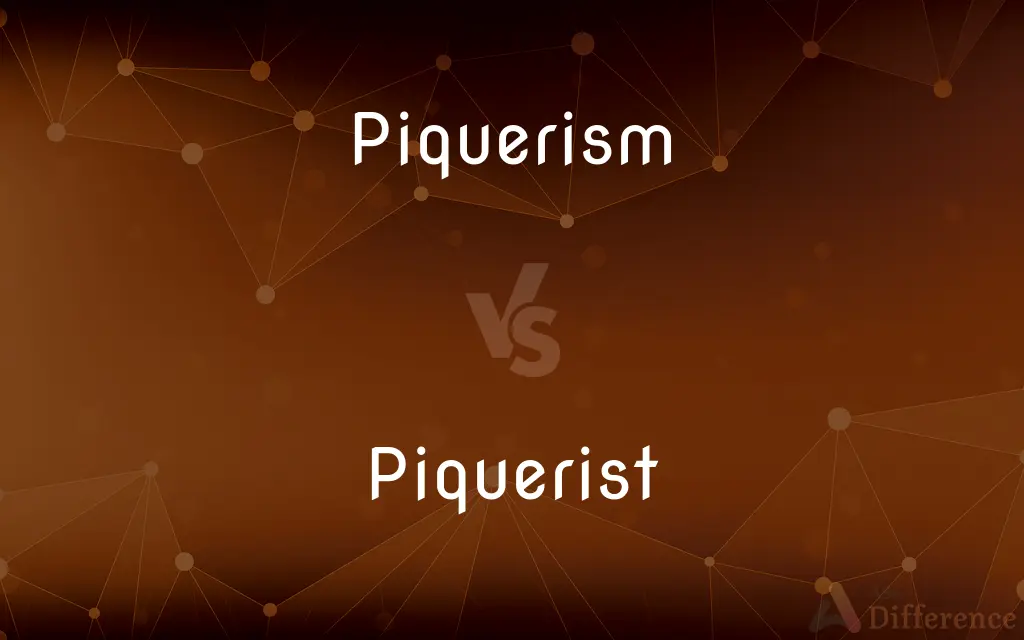Piquerism vs. Piquerist — What's the Difference?
By Fiza Rafique & Urooj Arif — Updated on April 28, 2024
Piquerism refers to deriving pleasure from piercing the skin with sharp objects, while a piquerist is someone who engages in piquerism.

Difference Between Piquerism and Piquerist
Table of Contents
ADVERTISEMENT
Key Differences
The act of piquerism can involve various sharp objects such as needles, knives, or pins, focusing on the sensory and psychological impact of penetration. On the other hand, a piquerist specifically seeks out these sensations and experiences, characterizing their actions by their choice of tools and methods.
Piquerism is often discussed in the context of criminal psychology and forensic studies due to its association with violent behavior. Meanwhile, understanding a piquerist involves exploring the psychological profile and motivations behind such actions.
In therapeutic settings, piquerism is treated as a psychological disorder that requires intervention. Conversely, therapy for a piquerist focuses on addressing the underlying causes and modifying the behavior.
Legal perspectives on piquerism categorize it as a potentially criminal activity, especially when non-consensual. However, identifying someone as a piquerist is crucial in legal contexts to determine the appropriate legal and psychological responses.
Comparison Chart
Context
Psychological, criminal, and forensic studies
Psychological profiling, criminal identification
ADVERTISEMENT
Focus
Sensation and experience of piercing
The individual’s motivations and actions
Objects Used
Needles, knives, pins
Same as piquerism, chosen by the individual
Legal Perspective
Considered a criminal act in non-consensual cases
Focus on identifying and modifying behavior
Compare with Definitions
Piquerism
Intervention for piquerism includes behavior modification therapies.
Cognitive-behavioral therapy is used to treat individuals showing tendencies of piquerism.
Piquerist
The profile of a typical piquerist includes a fascination with sharp objects.
During therapy, the piquerist discussed his long-standing interest in knives.
Piquerism
It is categorized under paraphilic disorders involving harmful or dangerous activities.
Therapists treat piquerism by addressing the psychological components of the paraphilia.
Piquerist
They may use tools like knives or needles to satisfy their urges.
The piquerist had a collection of sharp objects, as discovered by the police.
Piquerism
The practice is often explored in studies related to serial offenders.
Piquerism has been noted in several high-profile forensic cases involving serial criminals.
Piquerist
Intervention for a piquerist also includes legal consequences.
Legal actions against a piquerist include charges of assault or worse, depending on the severity of their actions.
Piquerist
Piquerists often require intensive psychological treatment.
A multi-disciplinary approach is necessary for effectively treating a piquerist.
Common Curiosities
How is piquerism treated?
Through psychological counseling and sometimes medication.
Who is a piquerist?
A person who engages in piquerism.
What is the difference between piquerism and sadism?
Piquerism specifically involves piercing the skin, while sadism can involve a broader range of behaviors.
What tools do piquerists use?
Commonly knives, needles, or other sharp objects.
Are all piquerists criminals?
Not necessarily, it depends on the context of their actions.
Is piquerism illegal?
It can be, particularly if it involves non-consensual acts.
Is piquerism considered a mental disorder?
It can be classified as a paraphilic disorder if it causes distress or harm.
Are there therapies specific to piquerists?
Yes, including cognitive-behavioral therapy and other behavioral interventions.
Can piquerism be consensual?
Yes, within certain BDSM practices it can be consensual.
How do forensic psychologists assess piquerists?
Through psychological evaluations and analysis of their behavior patterns.
How do legal systems handle piquerists?
They can face criminal charges if their actions harm others.
Can a piquerist change their behavior?
With appropriate treatment, it's possible for a piquerist to modify their behavior.
What motivates a piquerist?
Often a deep-seated need for control or to evoke fear.
Share Your Discovery

Previous Comparison
Herein vs. Hereon
Next Comparison
Intelligence vs. SophomaniaAuthor Spotlight
Written by
Fiza RafiqueFiza Rafique is a skilled content writer at AskDifference.com, where she meticulously refines and enhances written pieces. Drawing from her vast editorial expertise, Fiza ensures clarity, accuracy, and precision in every article. Passionate about language, she continually seeks to elevate the quality of content for readers worldwide.
Co-written by
Urooj ArifUrooj is a skilled content writer at Ask Difference, known for her exceptional ability to simplify complex topics into engaging and informative content. With a passion for research and a flair for clear, concise writing, she consistently delivers articles that resonate with our diverse audience.
















































